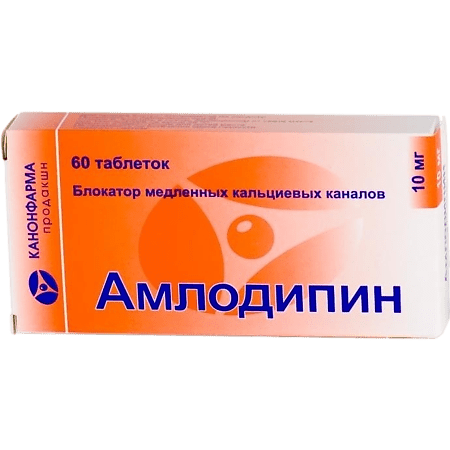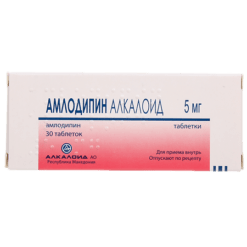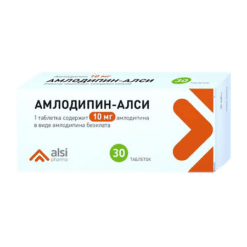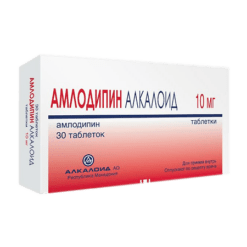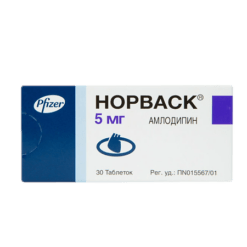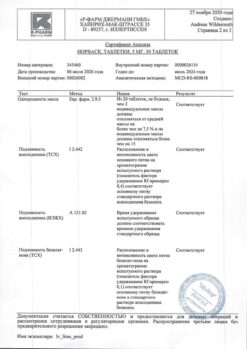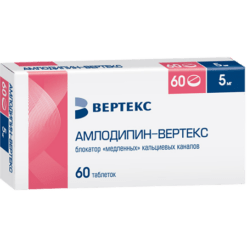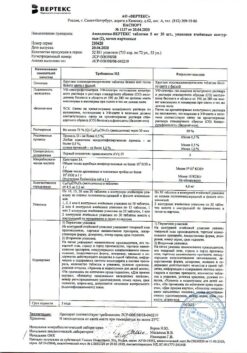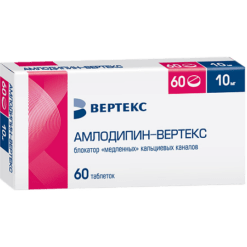No products in the cart.
Amlodipine, tablets 10 mg 60 pcs
€1.00
Out of stock
(E-mail when Stock is available)
Description
Pharmacodynamics
Amlodipine is a dihydropyridine derivative – a II generation “slow” calcium channels blocker (BMCC), has antianginal and hypotensive effect. Binding to dihydropyridine receptors, it blocks calcium channels, reduces transmembrane transition of calcium ions into cell (more in vascular smooth muscle cells than in cardiomyocytes).
Antianginal action is caused by the dilation of coronary and peripheral arteries and arterioles: in angina pectoris it reduces myocardial ischemia; dilation of peripheral arterioles reduces total peripheral vascular resistance; reduces myocardial preload on heart, oxygen demand. Dilates the main coronary arteries and arterioles in the unchanged and ischemic areas of the myocardium, increases the flow of oxygen to the myocardium (especially in vasospastic angina); prevents the development of coronary artery spasm (including that caused by smoking). In patients with angina a single daily dose increases exercise tolerance, delays the development of another angina attack and “coronary” ST-segment depression, reduces the frequency of angina attacks and nitroglycerin consumption.
Amlodipine has a long-term dose-dependent hypotensive effect, which is due to direct vasodilator effect on the vascular smooth muscles. In arterial hypertension a single daily dose of amlodipine provides clinically significant reduction of arterial pressure (BP) for 24 hours (in “lying” and “standing” position of the patient).
It reduces the degree of left ventricular myocardial hypertrophy and has anti-atherosclerotic and cardioprotective effect in ischemic heart disease (CHD). It does not affect myocardial contractility and conduction, inhibits platelet aggregation, increases glomerular filtration rate, has a weak natriuretic effect. In diabetic nephropathy it does not increase the severity of microalbuminuria. It has no adverse effect on metabolism and blood plasma lipid concentration. Time of onset of therapeutic effect is 2-4 hours, duration – 24 hours.
Pharmacokinetics
After oral administration amlodipine is slowly absorbed from the gastrointestinal tract. Food intake has no effect on absorption of amlodipine. The average absolute bioavailability is 64%. Maximum serum concentration is observed after 6-9 hours. The equilibrium concentration is reached after 7-8 days of therapy. The binding to plasma proteins is 95%. Average volume of distribution is 21 l/kg body weight. Amlodipine undergoes slow but active metabolism (90 to 97%) in the liver with no significant “first pass” effect. Metabolites have no significant pharmacological activity.
Half-life (T1/2) is on average – 35 hours. T1/2 in patients with arterial hypertension – 48 hours, in elderly patients – up to 65 hours, in hepatic insufficiency – up to 60 hours, similar parameters of increase of T1/2 are observed in severe chronic heart failure, in renal function disorders – it does not change.
About 60% of oral dose is excreted by kidneys mainly as metabolites, 10% – as unchanged, 20-25% – with bile and intestine as metabolites, as well as with breast milk.
Total clearance of amlodipine is 0.116 ml/s/kg (7ml/min/kg, 0.42 l/h/kg).
Amlodipine penetrates the blood-brain barrier. It is not excreted by hemodialysis.
Indications
Indications
Aarterial hypertension (monotherapy or in combination with other antihypertensive agents);
Stable tension angina and Prinzmetal angina (monotherapy or in combination with other antianginal agents).
Active ingredient
Active ingredient
Composition
Composition
1 tablet contains
the active ingredient:
amlodipine besylate, in terms of amlodipine 10 mg;
excipients:
calcium stearate,
potato starch,
lactose (milk sugar),
magnesium stearate,
microcrystalline cellulose.
How to take, the dosage
How to take, the dosage
Ingestion, regardless of meals.
For treatment of arterial hypertension and prevention of attacks of angina pectoris and vasospastic angina the initial dose of Amlodipine is 5 mg once daily. If necessary, the daily dose may be increased to a maximum of 10 mg (once daily).
Patients with hepatic impairment as hypotensive agent are prescribed with caution, in initial dose 2.5 mg (1/2 tablet of 5 mg), as antianginal agent – 5 mg.
In elderly patients, the T1/2 may increase and creatinine clearance (CC) may decrease. No dose changes are required, but closer monitoring of patients is necessary.
No dose changes are required when concomitantly administered with thiazide diuretics, beta-adrenoblockers and angiotensin-converting enzyme (ACE) inhibitors. No dose modification is required in patients with renal insufficiency.
Interaction
Interaction
Microsomal oxidation inhibitors may increase the plasma concentration of amlodipine, increasing the risk of side effects, and hepatic microsomal enzyme inducers may decrease this parameter.
Unlike other DMARDs, amlodipine has no clinically significant interaction with non-steroidal anti-inflammatory drugs, especially indomethacin.
Thiazide and “loop” diuretics, beta-adrenoblockers, verapamil, ACE inhibitors and nitrates increase antianginal or hypotensive effects of amlodipine.
Amiodarone, quinidine, alpha1-adrenoblockers, antipsychotics (neuroleptics) and isoflurane may increase the hypotensive effects of amlodipine.
Calcium preparations may decrease the effect of BMCC.
Concomitant use of amlodipine with lithium preparations may increase the neurotoxicity of the latter (nausea, vomiting, diarrhea, ataxia, tremor, tinnitus).
Amlodipine has no effect on pharmacokinetic parameters of digoxin and warfarin. Cimetidine has no effect on the pharmacokinetics of amlodipine.
Antiviral agents (ritonavir) contribute to increased plasma concentrations of PBMCs (including amlodipine).
Special Instructions
Special Instructions
During treatment with Amlodipine it is necessary to control patients’ body weight and sodium salt intake; an appropriate low-salt diet is prescribed.
It is necessary to maintain dental hygiene and regular visits to the dentist (to prevent soreness, bleeding and gum hyperplasia).
The dosing regimen of Amlodipine in elderly patients is similar to that in patients of other age groups. Careful monitoring of elderly patients is necessary when increasing the dose.
Although there is no withdrawal syndrome in BMKs, a gradual reduction in doses is recommended before discontinuing treatment.
Amlodipine does not affect plasma concentrations of potassium ions, glucose, triglycerides, total cholesterol, low-density lipoproteins, uric acid, creatinine and urea nitrogen.
Abrupt withdrawal of the drug should be avoided because of the risk of worsening the course of angina.
Amlodipine tablets are not recommended for hypertensive crises.
Patients with low body weight, short patients and patients with significant liver dysfunction may require a lower dose.
Influence on driving and operating machinery
There have been no reports about the effect of Amlodipine on driving or operating machinery. Nevertheless, drowsiness and dizziness may occur in some patients, mainly at the beginning of treatment. If they occur, caution should be exercised when driving motor transport and engaging in potentially dangerous activities requiring increased concentration and rapid psychomotor reactions.
Contraindications
Contraindications
With caution: Impaired liver function, sinus node weakness syndrome (marked bradycardia, tachycardia), chronic heart failure of non-ischemic etiology of NYHA functional class III-IV, aortic stenosis, mitral stenosis, hypertrophic obstructive cardiomyopathy, acute myocardial infarction (and within 1 month after), elderly age.
Side effects
Side effects
Cardiovascular system: often – palpitation, peripheral edema (edema of ankles and feet), infrequent – excessive reduction of BP, orthostatic hypotension, vasculitis; rarely – development or worsening of chronic heart failure; very rare – arrhythmias (bradycardia, ventricular tachycardia, atrial fibrillation), myocardial infarction, pain in the chest, migraine.
Central nervous system: often – headache, dizziness, increased fatigue; infrequently. malaise, fainting, asthenia, hypoesthesia, paresthesia, peripheral neuropathy, tremor, insomnia, emotional lability, unusual dreams, nervousness, depression, anxiety; rarely – seizures, apathy, agitation; very rarely – ataxia, amnesia.
Blood organs: very rarely – thrombocytopenia, leukopenia, thrombocytopenic purpura.
Respiratory system: infrequent – shortness of breath, rhinitis; very rare – cough.
Gastrointestinal tract disorders: frequent – nausea, abdominal pain; infrequent – vomiting, changes in defecation mode (including constipation, flatulence), dyspepsia, diarrhea, anorexia, dry oral mucosa, thirst; rare – gum hyperplasia, increased appetite; very rare – gastritis, pancreatitis, hyperbilirubinemia, jaundice (usually cholestatic), increased activity of “liver” transaminases, hepatitis.
Urinary system disorders: infrequent – pollakiuria, painful urge to urinate, nicturia, impotence; very rare – dysuria, polyuria.
Skin: rarely – increased sweating, very rare – cold sticky sweat, xeroderma, alopecia, dermatitis, purpura, discoloration.
Allergic reactions: infrequent – skin itching, rash; very rare – angioedema, erythema multiforme, urticaria.
Musculoskeletal system: infrequent – arthralgia, muscle cramps, arthrosis, myalgia (with long-term use), back pain; rarely – myasthenia.
Other: infrequent – alopecia, tinnitus, gynecomastia, weight gain/decrease, visual disturbance, diplopia, accommodation disturbance, xerophthalmia, conjunctivitis, eye pain, perversion of taste, chills, nasal bleeding, increased sweating; rare – dermatitis; very rare – cold sticky sweat, parosmia, skin pigmentation disorders, hyperglycemia.
Overdose
Overdose
Symptoms: marked BP decrease with possible development of reflex tachycardia and excessive peripheral vasodilation (risk of severe and persistent arterial hypotension, including development of shock and death).
Treatment: gastric lavage, administration of activated charcoal (especially in the first 2 hours after overdose), maintenance of cardiovascular function, control of heart and lung function parameters, Trendelenburg posture, control of circulating blood volume and diuresis. To restore vascular tone – application of vasoconstrictors (if there are no contraindications for their use); to eliminate the effects of calcium channel blockade – intravenous injection of calcium gluconate. Hemodialysis is not effective.
Pregnancy use
Pregnancy use
There has been no teratogenicity of amlodipine in animal studies, but there is no clinical experience with its use in pregnancy and lactation.
Therefore, amlodipine should not be administered to pregnant and lactating women or to women of childbearing age unless they use reliable contraception.
Similarities
Similarities
Additional information
| Shelf life | 3 years |
|---|---|
| Conditions of storage | In a dry, light-protected place at a temperature not exceeding 25 °C |
| Manufacturer | Kanonfarma Production ZAO, Russia |
| Medication form | pills |
| Brand | Kanonfarma Production ZAO |
Other forms…
Related products
Buy Amlodipine, tablets 10 mg 60 pcs with delivery to USA, UK, Europe and over 120 other countries.

